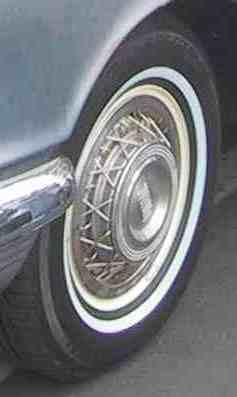
Pontiac Wire Wheel Covers
Information by Bob Johnson, pictures and editing by Larry
Gorden
November 2003. Last Update July 2010.
Wire wheel covers (hubcaps) were an option on Pontiacs from early 1950s up through 1958. The 1957-58 wire wheel covers were quite different than the earlier models and are described at the end of this article.
In 1956 the option was listed as "wire wheel disks" and was originally priced at $77.85!

1955 / 1956 Pontiac wire wheel covers
I'm told these wire wheel covers were manufactured by a company named Cello, and were available on many early to mid fifties marquees.
These covers were used on many makes including Nash/Nash-Healy, Kaiser Darren, Dodge, Desoto, Plymouth, Studebaker and Pontiac, to name a few. Typically, the centers and buckets are unique for each marquee and interchange for only limited model years. The centers are all generally the same dimension and contour, and bear the same impressed rings around the center of the cap. They differ only in the very center of the cap, where each marquee used their unique logos.
Parts that make up the wire wheel cover are, the basket, the bucket and the snap-in center. Also, there are three countersunk screws with nuts and washers that attach the basket to the bucket (only three of the six holes were used.)
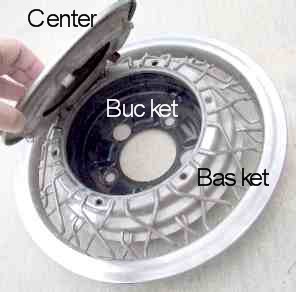
Parts of the wire hubcap
The Basket
The basket is the stainless steel spoke section.
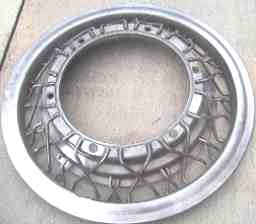
The Basket
The basket is the second most vulnerable piece, but is also the most readily available component primarily because it interchanges between all marquees that used 15" wheels and this type wire wheel cover. Because of it's "universal" fit, it reasonably should be the least expensive of the three components to acquire.
However, the baskets often suffered from tire iron damage inflicted by folks, including some mechanics, who didn't realize the cover was bolted onto the wheel, and thus bent the stainless rims trying to pry them off. A second source of damage was simple metal fatigue. The narrow section of stainless where the valve stem passes through the spokes and rim is the weak spot in the basket, and it's susceptible to flexing while in use. Consequently, these covers often begin to crack at the valve stem and can eventually split in two at this point. Lastly the baskets, like the centers, are susceptible damage from high curbs.
The Bucket
The bucket is the black painted part that attaches the hubcap to the wheel. The basket is fastened to the bucket using three 'stove bolt' screws with square nuts and washers. The bucket is bolted to the wheel with three of the five lug nuts. Note in the picture below that two of the holes are larger where the lug nuts do not hold the bucket to the wheel. This allows removing the wheel covers and still leave the wheel attached with two lug nuts..
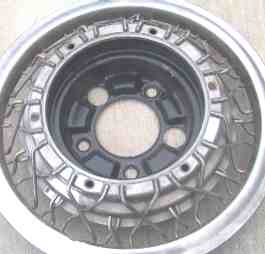
Basket setting on Bucket
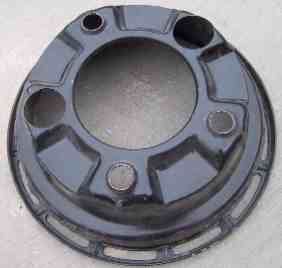
Back side (wheel side) of Bucket
The buckets are typically unique to each marquee, but often fit multiple years within a given marquee since wheel dimensions for individual makes didn't change that much in the 50's. The correct buckets to fit a '55-56 Pontiac are #22's. These numbers can be found stamped on the back of the bucket adjacent to one of the wheel stud holes.
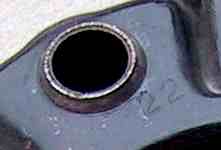
Stamped label designates application
Some buckets will interchange between different marquees. The fit is both for bolt circle diameter as well as depth of the bucket. For example a #46 bucket will match the bolt circle for a '55-56 Pontiac, but the stainless will stand out about 1/4"from the wheel rim, because the bucket is too deep to fit the Pontiac rim properly. The #46 bucket I believe fits Plymouth rims, but I'm unsure of what year(s) and/or model(s).
Generally, the bucket is the least vulnerable to damage of the three components, but they have their own set of problems. Most often they suffer from rust in the outer rim where the screws hold the stainless basket to the bucket (typical problem for rust-belt sources), or they have enlarged or damaged wheel stud holes (sometime they've been enlarged deliberately by someone attempting to mount them to a car with a different bolt circle dimension). The fasteners that hold the stainless to the bucket are simple flat or oval head straight slotted stove bolts with clipped flat washers and split lock washers and a square nut. The flat washer is clipped on two sides to fit the width of the bucket rim and keeps the washer from turning. Although there are six screw holes in the basket, only three sets of fasteners were used on each cover. The extra holes, presumably were to allow the basket to be slid around to adjust the valve stem opening location in the basket to fit the wheel with the bucket bolted in place.
The snap-in center is specific to the particular model with 1955 and 1956 Pontiacs using the same center. This part is most vulnerable and subject to "curb rash" so is the most difficult to find in good condition.
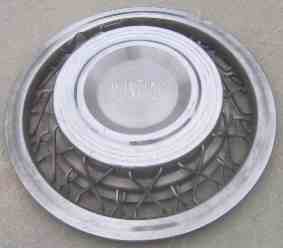
55/56 Center and Basket
The snap-in center component is typically unique to each marquee as well as limited model years. Held in place by spring clips, the centers were sometimes lost on the road due to fatigued or bent clips letting the cap go in a tight turn, or from glancing off a curb at speed. The center cap is also generally the first thing that hits a high curb (a good reason to have curb feelers) since it protrudes out past the fender opening. High curbs reeked havoc on many of these centers. Finding a full set of mint centers was a challenge 30 years ago when I was searching them out....and today it's gotta be even tougher.
1955 and 1956 used a center with white painted block letters "PONTIAC", and the rings around the center were painted white (not all marquees painted these rings). Styles for '55-56 centers included a polished finish on the center around the block letters, and a wire-brushed finish in the center around the block letters
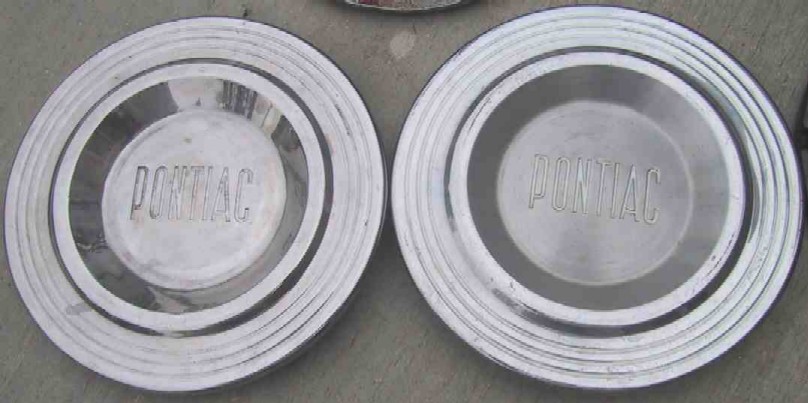
Two styles of 55/56 centers, polished (left) and wire-brushed (right).
These different styles makes collecting a full matched set for a '55 or '56 Pontiac even more difficult.
These two finish styles mimic the two styles of front bumper ornaments that were also manufactured with these two finishes. I've often wondered if a car equipped with brushed bumper ornaments would have also used wire-brushed wheel cover centers!? The similar finishes were probably just a coincidence, though.
In 53 and 54, Pontiac used a Lucite insert in the center as shown below (the wheel cover Lucite center is the same as used in the center of the grille). These pictures were captured from ebay ads.
|
1954 wire wheel cover |
|
The centers for other marquees that I've come across over the years include the following:
I'm told that Desoto and other marquees also used these wheel covers, and I believe I may have seen one of these, but was unable to identify the corresponding marquee. I've never actually seen any centers for any of these other marquees.
The aftermarket/generic "Cello" center (two of which I obtained as NOS pieces) used a low relief knight's helmet with crossed swords and a painted red & blue shield as their logo.
1957/58 Wire Wheel Covers
The following Deluxe Wire Wheel Cover was offered for 1957 and 1958 Pontiacs. 1957 was the first year of the 14 inch wheel for Pontiac, previous years used 15 inch wheels.
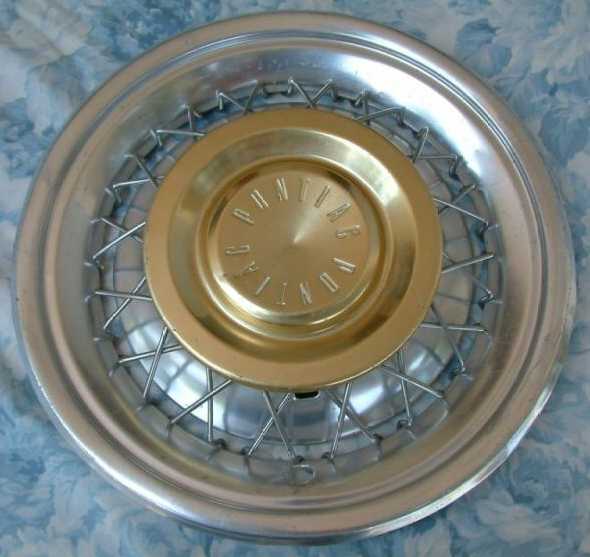
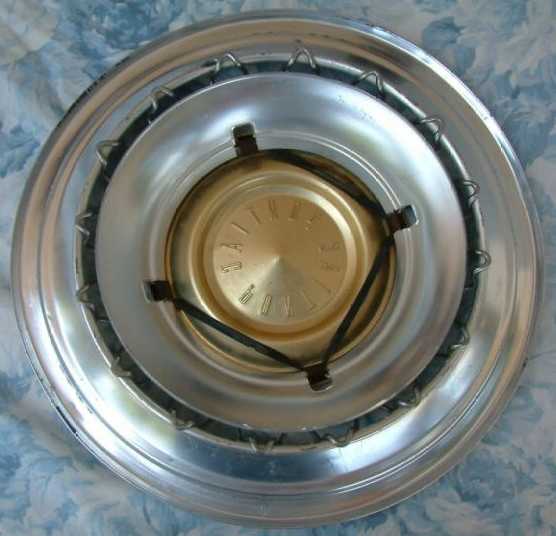
57/58 wire wheel cover.
These wheel covers are a different design than the 56 and
earlier wire wheel covers. They use clips to hold them to the rim and do
not use the bucket like the earlier models. They have stainless spokes and
aluminum rims and center cap; as opposed to earlier models which used all
stainless except for Lucite center inserts. Notice that the spoke pattern
is quite different (simpler) than earlier models.